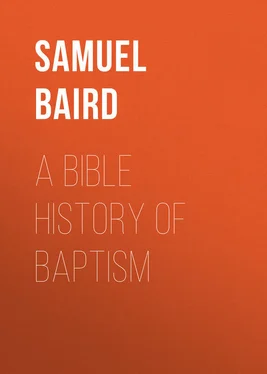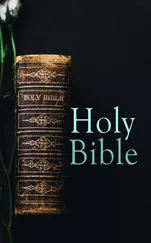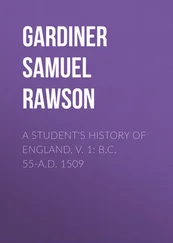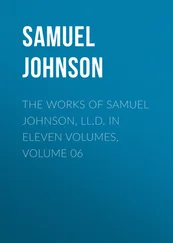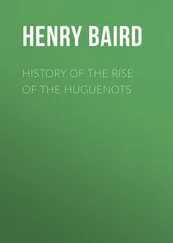Samuel Baird - A Bible History of Baptism
Здесь есть возможность читать онлайн «Samuel Baird - A Bible History of Baptism» — ознакомительный отрывок электронной книги совершенно бесплатно, а после прочтения отрывка купить полную версию. В некоторых случаях можно слушать аудио, скачать через торрент в формате fb2 и присутствует краткое содержание. Жанр: foreign_antique, foreign_prose, на английском языке. Описание произведения, (предисловие) а так же отзывы посетителей доступны на портале библиотеки ЛибКат.
- Название:A Bible History of Baptism
- Автор:
- Жанр:
- Год:неизвестен
- ISBN:нет данных
- Рейтинг книги:5 / 5. Голосов: 1
-
Избранное:Добавить в избранное
- Отзывы:
-
Ваша оценка:
- 100
- 1
- 2
- 3
- 4
- 5
A Bible History of Baptism: краткое содержание, описание и аннотация
Предлагаем к чтению аннотацию, описание, краткое содержание или предисловие (зависит от того, что написал сам автор книги «A Bible History of Baptism»). Если вы не нашли необходимую информацию о книге — напишите в комментариях, мы постараемся отыскать её.
A Bible History of Baptism — читать онлайн ознакомительный отрывок
Ниже представлен текст книги, разбитый по страницам. Система сохранения места последней прочитанной страницы, позволяет с удобством читать онлайн бесплатно книгу «A Bible History of Baptism», без необходимости каждый раз заново искать на чём Вы остановились. Поставьте закладку, и сможете в любой момент перейти на страницу, на которой закончили чтение.
Интервал:
Закладка:
Section XIX. — The Baptism of the Levites
The case of the Levites, in their cleansing and consecration, was peculiar. They had already enjoyed with the rest of the congregation the purifying rites and sprinkled seal of the Sinai covenant; and were thus, in the ordinary sense of the Mosaic ritual, clean, and competent to the enjoyment of the ordinances and privileges of Israel. But when they were set apart to a special nearness to God, in the service of the sanctuary, they were required to undergo additional ceremonies of purifying. Moses was instructed to “take the Levites from among the children of Israel and cleanse them. And thus shalt thou do unto them to cleanse them. Sprinkle water of purifying upon them; and let them shave all their flesh, and let them wash their clothes, and so make themselves clean.” They were then to bring two bullocks; “and the Levites shall lay their hands upon the heads of the bullocks, and thou shalt offer the one for a sin-offering, and the other for a burnt-offering, unto the Lord, to make an atonement for the Levites. And thou shalt set the Levites before Aaron and before his sons, and offer them for an offering unto the Lord. Thus shalt thou separate the Levites from among the children of Israel; and the Levites shall be mine.” – Num. viii, 6-14.
Section XX. — These all were one Baptism
The baptism of the Levites was official and peculiar. Its analogies to the other examples will readily occur to the reader, as we proceed. As to them, there is a common identity in all essential points, in form, meaning, and office. The design of the first administration at Sinai, and of all the attendant circumstances, was to impress Israel with a profound and abiding sense of the evil of sin, and of their own utter vileness and ruin as sinners in the presence of a God of infinite power, majesty, and holiness; and to illustrate to them the manner in which grace and salvation are given. In accepting that baptism, Israel professed to submit themselves to his sovereignty and accept him in the offices of his grace, as symbolized in the baptismal rites. On God’s behalf, the transaction was an acceptance and acknowledgment of them as his covenant people. The laws of defilement and the rites of purifying were continual reminders and re-enactings of the Sinai transaction, and for the same essential purpose, – the restoring to the fellowship of the covenant of those who came under its forfeiture. In each several case, sacrificial elements – blood or ashes – were applied by sprinkling. In each, those elements were mingled with running water, and the instrument for sprinkling was a bush of hyssop, and in each, scarlet and cedar were used.
The meaning of the scarlet, cedar, and hyssop is unexplained in the Scriptures. Expositors have wandered in conjectures, leading to no satisfactory conclusions. One result of their use is manifest. To us, devoid of meaning, they more distinctly mark the essential identity of the rites, in which they occupy the same place, and perform the same office. This may have been one design of their use.
The essential identity of these rites is altogether consistent with the minute variations in their forms. These had respect to the diversity of circumstances under which they were administered. The inferior dignity of a single person, a leper, as compared with the whole people, explains the acceptance of lambs or birds for his offerings, while bulls and goats were sacrificed for the nation. In the case of ordinary uncleannesses, the circumstances rendered special provision necessary. Sacrifice was lawful only at the sanctuary, which was the figure of the one holy place and altar where Christ ministers in heaven. But death and other causes of uncleanness were occurring everywhere. The ashes of the red heifer were, therefore, provided. They presented sacrificial elements in a form incorruptible and convenient for transportation. They were a most fitting representation of the “incorruptible blood of Christ.” And, as the proper place of the priests was at the sanctuary, and their presence could not be expected on every occasion of uncleanness elsewhere, it was appointed that any clean person might perform the sprinkling. This was, in fact, a mere ministerial sequel to the sacrificial rites, performed by the priest, at the burning of the red heifer. The probability of the circumstances, and intimations from the rabbins, lead to the conclusion that, as the priests multiplied and were released from the necessity of constant attendance at the sanctuary, they were commonly called to sprinkle the water of purifying. In fact, the Talmud indicates that in the later times the administration, when practicable, took place at Jerusalem, by the hands of the priests, with water from the pool of Siloam, which, flowing from beneath the temple, was recognized as a type of the Holy Spirit. 11 11 Compare Ezek. xlvii, 2; John ix, 7. “Go wash in the pool of Siloam, which is by interpretation, Sent.”
The minute variations traceable in these rites only make it the more clear that essentially, in form, meaning, and office, they were one baptism.
Section XXI. — This Symbol was derived from the Rain
We have seen, in the prophecy of Isaiah, the source whence the figure of sprinkling or pouring is derived. “I will pour water upon him that is thirsty, and floods upon the dry ground; I will pour my Spirit upon thy seed, and my blessing upon thine offspring; and they shall spring up as among the grass, as willows by the water courses.” – Isa. xliv, 3, 4. It is the descent of the rain from heaven, penetrating the earth, and converting its deadness into life, abundance, and beauty.
Herein the rites in question stand in beautiful contrast with the self-washings of the law. The latter accomplished a surface cleansing, by a process which neither could, nor was designed to penetrate the substance, or to affect its essential state or nature. They indicated to God’s people the duty of conforming the external life to the grace wrought in the heart by the Holy Spirit. But the rite of sprinkling represented the rain of God, sent down from heaven, penetrating the soil, pervading and saturating it, converting its hard, dead, and sterile clods into softness, life, and fertility, and causing the plants and fruits of the earth to spring forth, saturated with the same moisture, and thus possessed and pervaded with the same spirit of life. Thus was typified the work of the Spirit, entering, pervading, and softening the stony heart, converting all its powers and faculties as instruments of holiness to God, and causing the plants of righteousness to spring up and grow in the life and conduct.
The two words, sprinkle , and pour , are used throughout the Scriptures with reference to the same figure of rain, the only apparent difference being that the word, pour, expresses the idea of abundance. No phenomenon of nature is of greater manifest importance, or more pervasive and vital in its influences than the rain of heaven, and none more suitable to illustrate the method of grace. The land from which the rains are withheld is without fruit, or beauty, or attraction. It is given over to barrenness, death, and cursing; and, in the language of the Scriptures, is accounted unclean, as being shut out from the favor of God, whose favor is life. Hence, the word of God, to the prophet, concerning Israel: “Son of man, say unto her, Thou art the land that is not cleansed , nor rained upon , in the day of indignation.” – Ezek. xxii, 24. Similar is the significance of our Savior’s words: “When the unclean spirit is gone out of a man, he walketh through dry places” ( anhudrōn topōn , “waterless places”), places congenial to him because unblessed with the Spirit’s presence. (Matt. xii, 43; Luke xi, 24.)
Читать дальшеИнтервал:
Закладка:
Похожие книги на «A Bible History of Baptism»
Представляем Вашему вниманию похожие книги на «A Bible History of Baptism» списком для выбора. Мы отобрали схожую по названию и смыслу литературу в надежде предоставить читателям больше вариантов отыскать новые, интересные, ещё непрочитанные произведения.
Обсуждение, отзывы о книге «A Bible History of Baptism» и просто собственные мнения читателей. Оставьте ваши комментарии, напишите, что Вы думаете о произведении, его смысле или главных героях. Укажите что конкретно понравилось, а что нет, и почему Вы так считаете.
